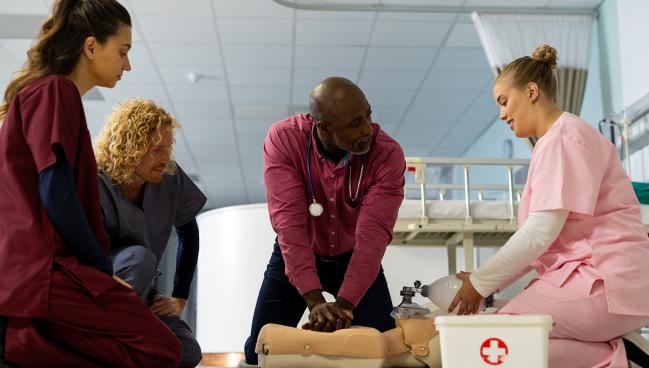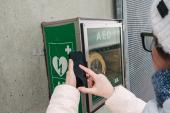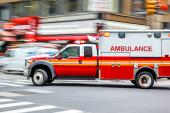Survival After Bystander CPR in OHCA Varies by Race/Ethnicity, Sex
The benefit does not appear to be as strong for Black people and women, say researchers. The question is: why?

Not all CPR is equal in terms of augmenting survival after out-of-hospital cardiac arrest (OHCA), according to an analysis of US registry data that uncovered racial/ethnic and sex differences.
Native American and white individuals, on the whole, derived the most benefit from bystander CPR and Black individuals the least, while men got a larger boost in survival than women.
Prior studies have tied race/ethnicity both to how likely a person is to receive bystander CPR and how likely a person is to live after OHCA. Bystanders also appear more reluctant to perform CPR on women compared with men. As a result, organizations like the American Heart Association and Red Cross have prioritized training to more people as a way to make inroads into the lack of CPR.
This “yes/no dichotomy” may lack nuance, lead author Paul S. Chan, MD (Saint Luke’s Mid America Heart Institute, Kansas City, MO), told TCTMD. “Maybe we haven’t thought about it with enough complexity, which is to say: when people get bystander CPR, does everyone get the same benefit?”
The magnitude of the differences they found came as a surprise, he said. “For whatever reason, the benefits of bystander CPR—when delivered—may not be as high for Black individuals and for women.”
Maybe part of the challenge is we don’t normalize [a diverse range of] body shapes, sizes, and colors. Paul S. Chan
For their study, published online recently in Circulation, the researchers turned to the Cardiac Arrest Registry to Enhance Survival (CARES) database. The registry tracks all nontraumatic OHCAs for which resuscitation is attempted in a sample that captures around half of US residents.
Chan et al identified 623,342 patients who experienced nontraumatic OHCA between 2013 and 2022. Mean age was 62.1 years, and 35.9% were women. Half were non-Hispanic white, 20.6% non-Hispanic Black, 19.0% unknown, 7.3% Hispanic, 2.9% Asian, and 0.4% Native American. More than 80% of the events occurred at home, presumed to have a cardiac cause, and had an initial nonshockable rhythm.
Among individuals with OHCA listed as white, Asian, or unknown race/ethnicity, 42% got CPR. Rates were 39.4%, 38.1%, and 31.3% among Native American, Hispanic, and Black individuals, respectively. Women and men were equally apt to receive bystander CPR, at 39% and 40%, respectively.
Just one in 10 people with OHCA survived to hospital discharge. No matter their race/ethnicity or sex, patients were more likely to live if they received bystander CPR.
However, the degree of impact did differ. The link between CPR and survival was strongest for Native-American and white individuals. It was weakest among Black individuals, while people of Hispanic, Asian, and “unknown” backgrounds fell in the middle of the spectrum. There were sex-related differences as well, with CPR being more protective in men than in women.
Survival After OHCA: With vs Without CPR
|
|
Adjusted OR |
95% CI |
|
Race/Ethnicity Native American White Unknown Hispanic Asian Black |
1.40 1.33 1.31 1.29 1.27 1.09 |
1.02-1.90 1.30-1.37 1.25-1.36 1.20–1.39 1.12-1.42 1.04-1.14 |
|
Sex Men Women |
1.35 1.15 |
1.31-1.38 1.12-1.19 |
Race/ethnicity and sex had overlapping effects, the researchers found. Black women derived the least survival benefit from bystander CPR (adjusted OR 1.05; 95% CI 0.97-1.13) and white men derived the most (adjusted OR 1.41; 95% CI 1.37-1.46).
Similar patterns were seen for the endpoint of favorable neurological survival. Additional analyses confirmed that the weaker connection between CPR and outcome existed for Black people and women irrespective of the neighborhood’s racial/ethnic mix or income level.
No Clear Culprit
What these results could indicate is that there are differences in how well CPR is being performed, said Chan, perhaps due to hesitancy over cultural taboos or concerns that certain people may be frailer than others. For example, “it’s striking that I’ve never actually seen, in all my years recertifying every other year for CPR, a manikin with breasts. Maybe part of the challenge is we don’t normalize [a diverse range of] body shapes, sizes, and colors” during training, he noted.
As a solution, “more pervasive use of manikins that resemble women’s bodies and reflect other races and ethnicities in CPR training may normalize layperson response and improve bystander CPR quality for these patient groups,” the researchers suggest.
Another potential cause is that some bystanders did CPR on their own while others had input from a 9-1-1 dispatcher while awaiting emergency medical services. And finally, differences in comorbidity burden might be affecting survival even when CPR is of consistent quality, though Chan noted their data didn’t support this notion.
Variations in the time to bystander CPR or arrival of emergency responders were too modest to fully explain the imbalances, the paper notes. Additionally, racial bias in and of itself also is an unlikely culprit, since most of the OHCAs occurred at home, where CPR would be done by family members or acquaintances.
Still, “none of the explanations we thought about were satisfying enough to say, ‘Maybe this is a really strong possibility,’” Chan commented.
As for what research should come next, Chan noted that “there’s very little in the literature about bystanders.” For instance, some patients may receive CPR from just one person on the scene, while others may have multiple people helping out. That said, collecting such details for research purposes during an emergency is difficult, he added.
Chan stressed the need to address the bigger picture: “We really need to look at bystander CPR as a twofold [issue]. We need to get more people to do it, and then we need to make sure that when they start CPR, they can do it effectively.”
Caitlin E. Cox is News Editor of TCTMD and Associate Director, Editorial Content at the Cardiovascular Research Foundation. She produces the…
Read Full BioSources
Chan PS, Girotra S, Blewer A, et al. Race and sex differences in the association of bystander CPR for cardiac arrest. Circulation. 2024;Epub ahead of print.
Disclosures
- Chan reports no relevant conflicts of interest.





Comments